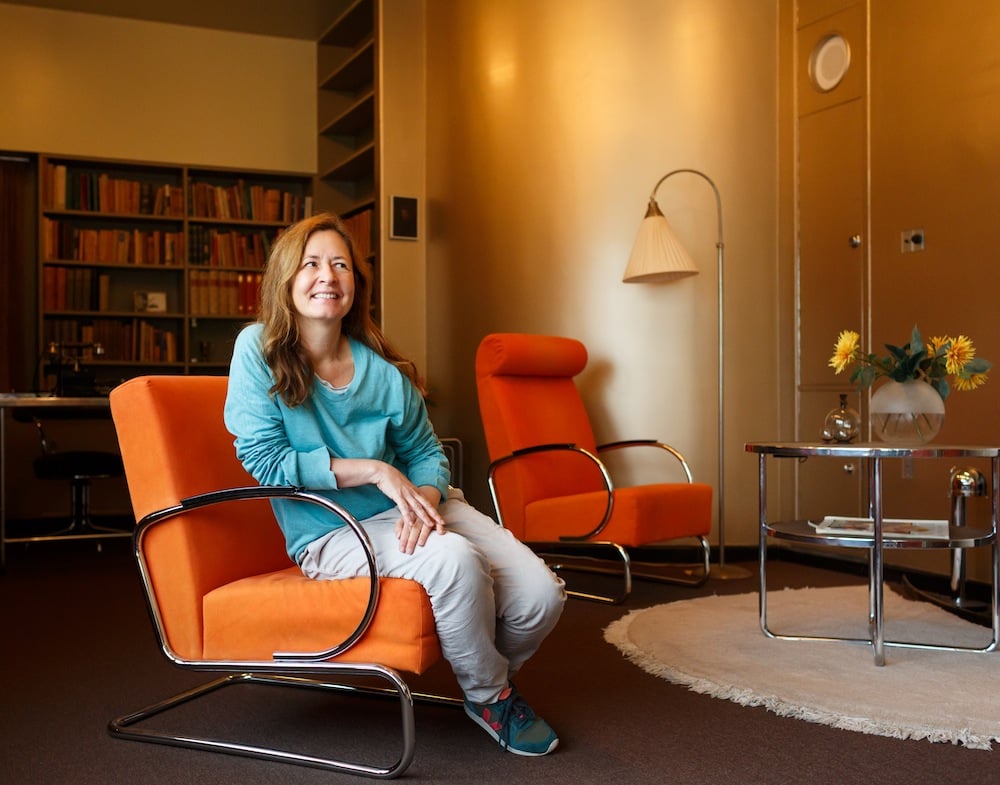
“There are a few words I really don’t like: video, installation, performance,” proclaims Dominique Gonzalez-Foerster. She looks up from the table, upon which she is absentmindedly arranging pieces of a broken biscotti. “I like apparitions, ghosts, projections … You will see characters.”
She is referring to her exhibition “QM.15,” at Esther Schipper in Berlin, which at the time of our meeting is still being installed. From the gallery’s back office, cinematic noise can be heard from the exhibition space, although nobody is allowed to see what’s inside until after the official opening.
“There is a big part that is magic, and I am absolutely against showing how it’s made,” she apologizes.
“QM.15” is an iteration of the French artist’s ongoing series of “apparitions,” where she appears made up and costumed as historical, literary, or cinematic characters. These specific apparitions were originally conceived as a triple threat for the Centre Pompidou in Paris, where Sarah Bernhardt becomes Marilyn Monroe becomes Maria Callas, all mediated by Gonzalez-Foerster.
Installation view of “Costumes & Wishes for the 21st century.” Photo courtesy of Schinkel Pavillon.
Another Berlin exhibition, however, is already on view: “Costumes & Wishes for the 21st century,” a collaboration with two design studios at the Schinkel Pavillon. There, her apparitions’ costumes are on display, staged colorfully and conceptually in collaboration with interdisciplinary design studio Manuel Raeder.
Downstairs, elusive fashion collective BLESS created a series of adaptations of Gonzalez-Foerster’s costumes, which visitors can try on in order to become their own visions of personalities like Marilyn Monroe; Fitzcarraldo, from the Werner Herzog film; or the titular character from Joseph Losey’s 1948 film The Boy with the Green Hair. Makeup artists, bartenders, and a mirrored ceiling round out the playful and interactive “Cosplay Sundays.”
Gonzalez-Foerster works with a wide cast of legendary characters; her practice is steeped in literature, film, and opera. When it comes to making new apparitions, she says, characters approach her with as much mystery as they appear before the viewer.
“I’m not sure if I choose them or if they choose me,” she wonders. “I don’t think it’s so much an idea of choice—that would be like going to a store. It’s a much longer process. I may have seen a film 20 or 30 years ago and the character stayed with me.”
Installation view of “Costumes & Wishes for the 21st century.” Photo courtesy of Schinkel Pavillon.
The current exhibition of Bernhardt, Monroe, and Callas in Berlin was born of a long-held fascination with creative women who styled themselves as living, breathing artworks. Gonzalez-Foerster speaks about the 19th-century Italian aristocrat Countess da Castiglione, who directed photoshoots of herself dressed in elaborate costume, emulating mythical, literary, or altogether imagined characters. She continues on about the early-20th-century Italian socialite Luisa Casati, notorious for her collection of exotic animals she used as accessories, and for proclaiming that she aimed to “be a living work of art.”
“Women like them, and many others, really paved the way for artists working with representation—like Cindy Sherman for example—and on the other side, the stage as an ultimate moment of artistic presence,” Gonzalez-Foerster explains.
Installation view of “Costumes & Wishes for the 21st century.” Photo courtesy of Schinkel Pavillon.
Like Castiglione and Casati, the apparitions at Esther Schipper represent women who had extreme commitments to their art; and—as opposed to object-oriented artmaking—the immediacy, intangibility, and consuming nature of performative acts.
“They really explored their practice to the limit,” she says. “It’s not about art as a kind of hobby, it’s art as a vortex, as something crazy that takes over as a possession. One of the most interesting or important aspects for me is really to completely merge the moment of presence and creation in a way. The singers or the actors, they’re lucky to be completely in the present in their art, when they perform they’re just there.”
Installation view of “Costumes & Wishes for the 21st century.” Photo courtesy of Schinkel Pavillon.
Gonzalez-Foerster maintains a modest appearance in everyday life—a far cry from the outrageous stunts of Italian heiresses—but through her work, and hours of hair and makeup, she understands the commitment required to appear as an iconic character. Exemplifying her obsession with literature and film, she compares her preparation process to the Woody Allen film Irrational Man.
“The main character is a philosophy teacher who is a bit bored. One day, for some reason, he gets the motivation to kill someone. He does all this plotting and preparation, and goes from being a depressed character to someone different. I realized that when I am preparing for an apparition, there is a whole dimension that makes life more interesting to me. There is an attempt to reach an unknown point.”